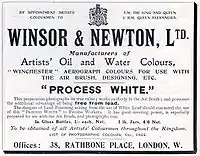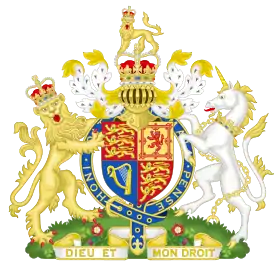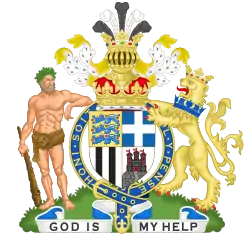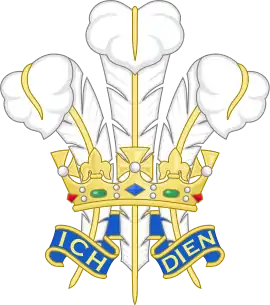Winsor & Newton
Winsor & Newton (also abbreviated W&N) is an English manufacturing company based in London that produces a wide variety of fine art products, including acrylics, oils, watercolor, gouache, brushes, canvases, papers, inks, graphite and colored pencils, markers, and charcoals.
 | |
| Type | Private |
|---|---|
| Industry | Art materials |
| Founded | 1832 in London |
| Founder | William Winsor and Henry Newton |
| Headquarters | , |
Area served | Worldwide |
| Products | acrylics, oils, watercolor, gouache, brushes, canvases, papers, inks, graphite and colored pencils, markers, charcoal |
| Brands | Artist's Hog, Azanta, Winton, Cotman, Monarch, Artisan, Sceptre |
| Parent | Colart Group [1] |
| Website | winsornewton.com |
History

The company was founded in 1832 by William Winsor and Henry Newton. The firm was originally located at Henry Newton's home in 38 Rathbone Place, London. This was then part of an artists' quarter in which a number of eminent painters, including Constable, had studios, and other colourmen were already established.[2]
The standards of quality for W&N's most renowned line of kolinsky sable brush, the Series 7, began after Queen Victoria ordered it should be "the very finest watercolour brush" in 1866. A few months before his death, Henry Newton sold the business to the newly incorporated firm of "Winsor & Newton Ltd.", which included members of both families amongst the shareholders. In 1937, W&N introduced its gouache paints.[2]
The company moved to Wealdstone in northwest London in 1937. After World War II, W&N opened a brush-making factory in Lowestoft. In 1970, the company introduced its first range of acrylics, and the first artists' alkyd oil colour came six years later. Later, in 1992, a series of oil bars were launched.[2]
The Winsor & Newton student range of watercolours was named after John Sell Cotman.
Products
Art products made by Winsor & Newton, distinguished by size, series, material and function (eg. effects or process).[3]
| Product | Range / brand |
|---|---|
| Brushes | Natural hair (kolinsky sable -Series 7, squirrel, hog -Artist's Hog, Azanta, Winton), synthetic fibers (Cotman, Monarch, Artisan, Galeria), natural/synthetic mix (Sceptre) |
| Paints | Oil (Winton, Artist's, Griffin Artisan), acrylic (Galeria, Finity), watercolour (Cotman, Artist's), gouache (Designers), marker pens (Promarker), (Promarker Brush), (Promarker Watercolour), charcoal, graphite and colored pencils |
| Inks | Drawing and calligraphy inks |
| Papers | Watercolor, oil (Winton), acrylic (Galeria), marker, sketching |
| Canvas | Cotton, polycotton |
| Accessories | Canvas boards, solvents, masking fluids, varnishes, easels, travel bags, brush holders, stools, instructional books |
In popular culture

The Winsor & Newton paints are repeatedly referenced in Dorothy Sayers' 1931 detective novel Five Red Herrings, whose plot deals with a painter being murdered and six other painters being suspected of killing him. The painting habits of the suspects, including which kind of paint is used by each, turn out to provide crucial clues that eventually lead Lord Peter Wimsey to the real culprit.
In Michel Bussi's 2011 detective novel Black Waterlilies (French: Nymphéas Noirs) set in Giverny, "Winsor and Newton" is frequently referenced, although it is imagined to be an American, rather than a British, company.
Karlheinz Stockhausen and his studio assistants read product names from the Winsor & Newton catalogue aloud in his electronic composition Hymnen.
Notes
References
- Our businesses: ColArt Lindéngruppen. Retrieved 17 August 2016.
- Winsor & Newton timeline
- Winsor & Newton products, 20 Aug 2020



.svg.png.webp)

